The "exotic" nuclei pose the challenge of a universal description of the nuclear structure and raise the question of the evolution of the shell structure. An IRFU team has developed the Magic Number Off Stability (MINOS) project to answer these questions. A physics program has been established in collaboration with Japanese teams of the RIKEN institute, where RIBF (Radioactive Isotope Beam Factory) is the world's most efficient accelerator for producing neutron-rich nuclei at intermediate energies of several hundreds of MeV. Experiments with the MINOS detector began in 2014 and their first results have just been published in Physical Review Letters crowning five years of effort and paving the way for a harvest of exciting results in the years to come.
In atomic nuclei, the interactions between nucleons are at the origin of the "nuclear structure" and phenomena that depend, in part, on the asymmetry of the numbers of protons and neutrons. The nuclear structure, as we know it today, has been established mainly by the study of stable nuclei. The "exotic" nuclei differ from stable nuclei by their neutron-proton asymmetry and / or their low binding energy, therefore they give us new study conditions. In a similar way to atomic physics, nucleons (protons or neutrons) in the nucleus occupy ordered orbitals. This arrangement of orbitals is not universal for all nuclei. Differences have already been observed between stable and exotic nuclei, which reflect different correlations between nucleons. These differences are enhanced approaching the driplines (the limits of existence for nuclei with very unusual proton / neutron asymmetries) this is the case of neutron skins and halos with "di-neutron" correlations.
Exotic nuclei raise fundamental questions:
• Can we come up with a universal description of the nuclear structure?
• What is the origin of the evolution of the shell structure of nuclei?
• How do the so-called "di-neutron" correlations appear in Borromeean nuclei?
• What is the role of the underlying structure of nucleons in nuclear structure?
An IRFU team of DACM, DEDIP, DIS and DPhN technicians, engineers and researchers built the MINOS program to answer these questions. A physics program has been established in collaboration with the RIKEN Nishina Center. Today RIKEN with the Radioactive Isotope Beam Factory (RIBF) is the world's most efficient accelerator for producing neutron-rich nuclei at intermediate energies of several hundred MeV.
The first physics issues that the collaboration tackled are:
see the Minos page project for detailed information about the detection principle and performances.

Physics program to perform the first spectroscopy of neutron-rich nuclei covered by SEASTAR. 2/3 of this program were successfully completed in May 2014 and May 2015.
The SEASTAR (Shell Evolution And Search for Two-plus energies at the RIBF) collaboration between Irfu and RIKEN Nishina Center first objectives were to perform the first gamma spectroscopy of the most exotic nuclei that can be reached today, based on on the operation of MINOS coupled to the DALI2 photon detector at the RIBF. The collaboration has gathered more than 100 physicists worldwide. The program of SEASTAR with MINOS is illustrated in the figure.
The first result obtained with MINOS was published in Physical Review Letters [2].
It deals with the spectroscopy of 66Cr, 70,72Fe. The experiment has shown that the neutron-rich Cr and Fe isotopes have very low energy first excited levels whose excitation energy varies little from one isotope to another. This plateau is interpreted in the shell model as a combined effect of deformation and pairing correlations. It raises the question of the robustness of the nuclear magic number N = 50 for the isotopes of Cr and Fe, in the region of 78Ni, expected as a doubly magic nucleus within the shell model.
References of the first publications
Contacts: Anna Corsi, Alexandre Obertelli, Clémentine Santamaria
• Structure of nuclear matter › Atomic nucleus
• Accelerators, Cryogenics and Magnetism Division (DACM) • Institute of Research into the Fundamental Laws of the Universe • The Electronics, Detectors and Computing Division • The Nuclear Physics Division • The Systems Engineering Division
• LENA group - Structure of the Atomic Nuclei
• MINOS
